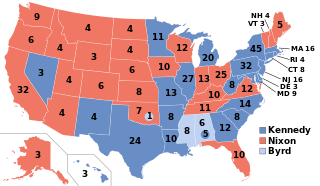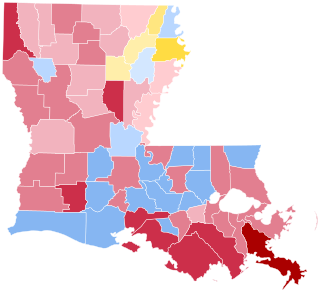
The 1956 United States presidential election was the 43rd quadrennial presidential election. It was held on Tuesday, November 6, 1956. President Dwight D. Eisenhower successfully ran for reelection against Adlai Stevenson II, the former Illinois governor whom he had defeated four years earlier. This election saw the sixth and most recent rematch in presidential history, and the second where the winner was the same both times. This was the last election before the term limits established by the 22nd Amendment came into effect.

The 1960 United States presidential election was the 44th quadrennial presidential election. It was held on Tuesday, November 8, 1960. In a closely contested election, Democratic Senator John F. Kennedy defeated the incumbent Vice President Richard Nixon, the Republican nominee. This was the first election in which 50 states participated, marking the first participation of Alaska and Hawaii, and the last in which the District of Columbia did not. This made it the only presidential election where the threshold for victory was 269 electoral votes. It was also the first election in which an incumbent president –in this case, Dwight D. Eisenhower– was ineligible to run for a third term because of the term limits established by the 22nd Amendment.

The 1964 United States presidential election was the 45th quadrennial presidential election. It was held on Tuesday, November 3, 1964. Incumbent Democratic President Lyndon B. Johnson defeated Senator Barry Goldwater, the Republican nominee, in a landslide. Johnson was the fourth and most recent vice-president to ascend to the presidency following the death of his predecessor and to win a full term in his own right. With 61.1% of the popular vote, Lyndon B. Johnson won the largest share of the popular vote for the Democratic Party in history, and the highest for any candidate since the advent of widespread popular elections in the 1820s.

The 1968 United States presidential election was the 46th quadrennial presidential election, held on Tuesday, November 5, 1968. The Republican nominee, former vice president Richard Nixon, defeated both the Democratic nominee, incumbent vice president Hubert Humphrey, and the American Independent Party nominee, former Alabama governor George Wallace. This was the last election until 1988 in which the incumbent president was not on the ballot. This was also the last election where a third-party candidate received an electoral vote.
In United States presidential elections, an unpledged elector is a person nominated to stand as an elector but who has not pledged to support any particular presidential or vice presidential candidate, and is free to vote for any candidate when elected a member of the Electoral College. Presidential elections are indirect, with voters in each state choosing electors on Election Day in November, and these electors choosing the president and vice president of the United States in December. Electors in practice have since the 19th century almost always agreed in advance to vote for a particular candidate — that is, they are said to have been pledged to that candidate. In several elections in the 20th century, however, competitive campaigns were mounted by candidates who made no pledge to any presidential nominee before the election. These anomalies largely arose from fissures within the Democratic Party over the issues of civil rights and segregation. No serious general election campaign has been mounted to elect unpledged electors in any state since 1964.

From March 10 to June 2, 1964, voters of the Republican Party elected 1,308 delegates to the 1964 Republican National Convention through a series of delegate selection primaries and caucuses, for the purpose of determining the party's nominee for president in the 1964 United States presidential election.
Hubert Horatio Humphrey served as the 38th Vice President of the United States (1965–1969), as a United States senator from Minnesota, and as the 35th mayor of Minneapolis, Minnesota (1945–1948).

This is the electoral history of Adlai Stevenson II, who served as Governor of Illinois (1949–1953) and 5th United States Ambassador to the United Nations (1961–1965), and was twice the Democratic Party's nominee for President of the United States, losing both the 1952 and 1956 presidential general elections to Republican Dwight D. Eisenhower.

Electoral history of Barry Goldwater, United States Senator from Arizona and Republican Party nominee for President of the United States during 1964 election

From March 8 to June 7, 1960, voters of the Republican Party chose its nominee for president in the 1960 United States presidential election. Incumbent Vice President Richard Nixon was selected as the nominee through a series of primary elections and caucuses culminating in the 1960 Republican National Convention held from July 25 to July 28, 1960, in Chicago, Illinois.

The 1972 United States presidential election in Vermont took place on November 7, 1972, as part of the 1972 United States presidential election which was held throughout all 50 states and the District of Columbia. Voters chose three representatives, or electors to the Electoral College, who voted for president and vice president.

The 1960 United States presidential election in New Jersey took place on November 8, 1960. All 50 states were part of the 1960 United States presidential election. Voters chose 16 electors to the Electoral College, which selected the president and vice president.

The 1972 United States presidential election in Florida was held on November 7, 1972, as part of the concurrent United States presidential election. Florida voters chose seventeen electors, or representatives to the Electoral College, who voted for president and vice president. Incumbent Republican President Richard Nixon won the state over the Democratic nominee, South Dakota Senator George McGovern, by a landslide margin of 44.11% and over one million votes.

The 1956 United States presidential election in Minnesota took place on November 6, 1956, as part of the 1956 United States presidential election. Voters chose 11 electors, or representatives to the Electoral College, who voted for president and vice president.

The 1972 United States presidential election in Idaho took place on November 7, 1972, as part of the 1972 United States presidential election. Idaho voters chose four representatives, or electors, to the Electoral College, who voted for president and vice president.

The 1968 United States presidential election in Mississippi was held on November 5, 1968. Mississippi voters chose seven electors, or representatives to the Electoral College, who voted for President and Vice-President.

The 1960 United States presidential election in Mississippi took place on November 8, 1960, as part of the 1960 United States presidential election. Voters chose eight representatives, or electors to the Electoral College, who voted for president and vice president. This was the last election in which Mississippi had eight electoral votes: the Great Migration caused the state to lose congressional districts for the third time in four censuses before the next election.

The 1956 United States presidential election in Mississippi was held on November 6, 1956. Mississippi voters chose eight representatives, or electors to the Electoral College, who voted for president and vice president.

The 1956 United States presidential election in Louisiana took place on November 6, 1956, as part of the 1956 United States presidential election. State voters chose ten representatives, or electors, to the Electoral College, who voted for president and vice president.

The 1956 United States presidential election in Maryland took place on November 6, 1956, as part of the 1956 United States presidential election. State voters chose nine representatives, or electors, to the Electoral College, who voted for president and vice president.


























